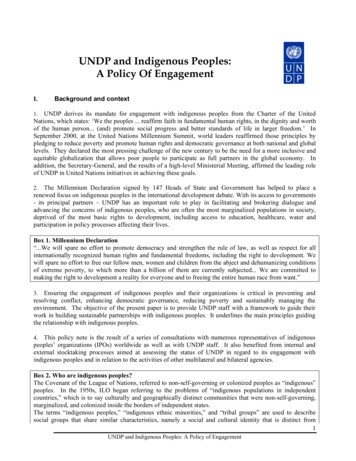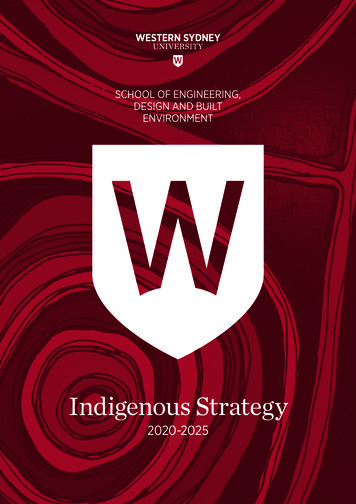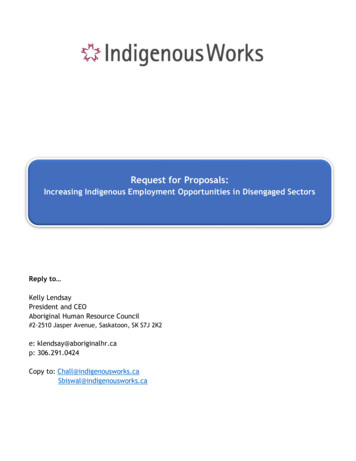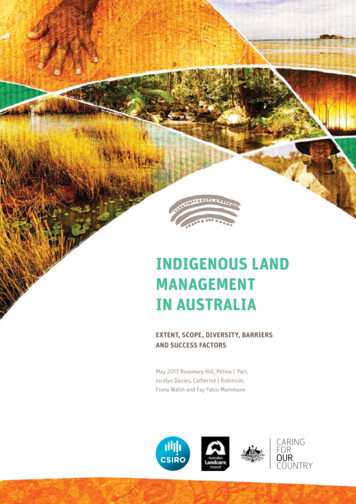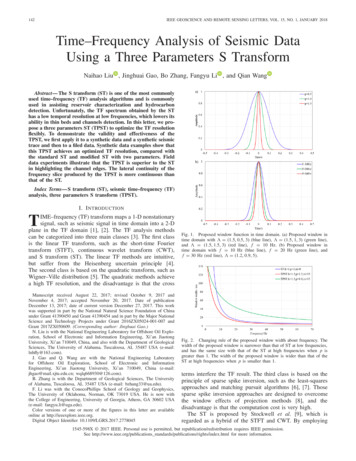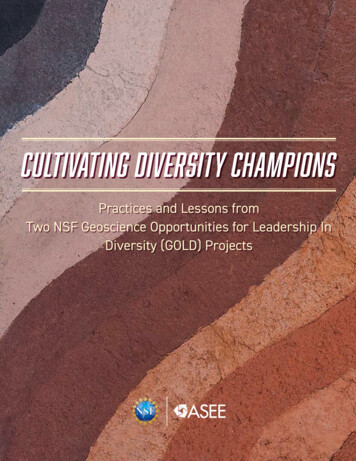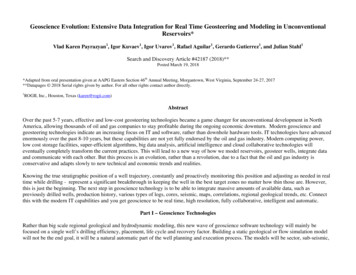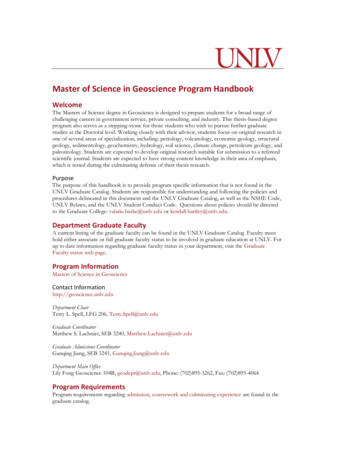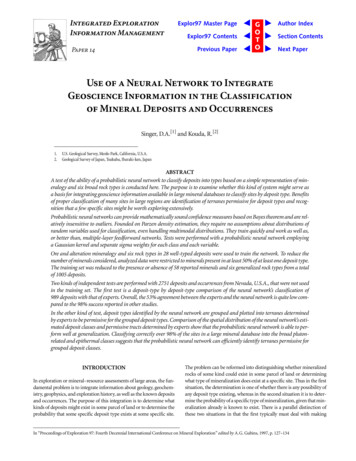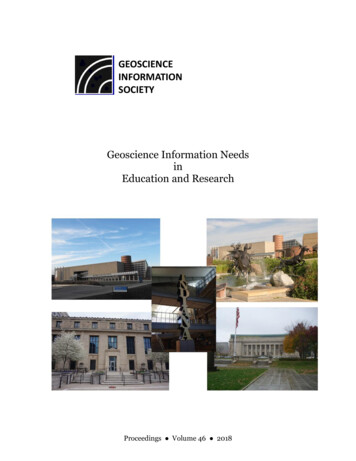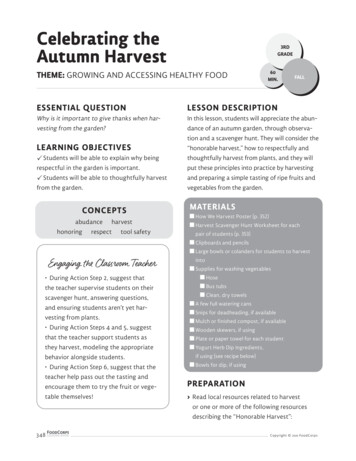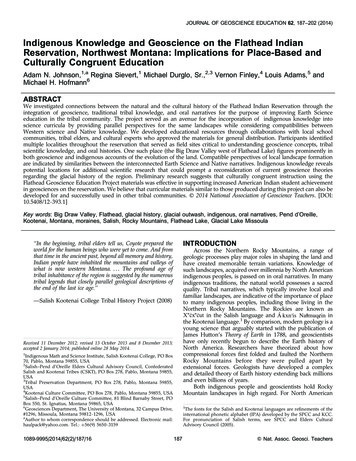
Transcription
JOURNAL OF GEOSCIENCE EDUCATION 62, 187–202 (2014)Indigenous Knowledge and Geoscience on the Flathead IndianReservation, Northwest Montana: Implications for Place-Based andCulturally Congruent EducationAdam N. Johnson,1,a Regina Sievert,1 Michael Durglo, Sr.,2,3 Vernon Finley,4 Louis Adams,5 andMichael H. Hofmann6ABSTRACTWe investigated connections between the natural and the cultural history of the Flathead Indian Reservation through theintegration of geoscience, traditional tribal knowledge, and oral narratives for the purpose of improving Earth Scienceeducation in the tribal community. The project served as an avenue for the incorporation of indigenous knowledge intoscience curricula by providing parallel perspectives for the same landscapes while considering compatibilities betweenWestern science and Native knowledge. We developed educational resources through collaborations with local schoolcommunities, tribal elders, and cultural experts who approved the materials for general distribution. Participants identifiedmultiple localities throughout the reservation that served as field sites critical to understanding geoscience concepts, tribalscientific knowledge, and oral histories. One such place (the Big Draw Valley west of Flathead Lake) figures prominently inboth geoscience and indigenous accounts of the evolution of the land. Compatible perspectives of local landscape formationare indicated by similarities between the interconnected Earth Science and Native narratives. Indigenous knowledge revealspotential locations for additional scientific research that could prompt a reconsideration of current geoscience theoriesregarding the glacial history of the region. Preliminary research suggests that culturally congruent instruction using theFlathead Geoscience Education Project materials was effective in supporting increased American Indian student achievementin geosciences on the reservation. We believe that curricular materials similar to those produced during this project can also bedeveloped for and successfully used in other tribal communities. Ó 2014 National Association of Geoscience Teachers. [DOI:10.5408/12-393.1]Key words: Big Draw Valley, Flathead, glacial history, glacial outwash, indigenous, oral narratives, Pend d’Oreille,Kootenai, Montana, moraines, Salish, Rocky Mountains, Flathead Lake, Glacial Lake MissoulaINTRODUCTION‘‘In the beginning, tribal elders tell us, Coyote prepared theworld for the human beings who were yet to come. And fromthat time in the ancient past, beyond all memory and history,Indian people have inhabited the mountains and valleys ofwhat is now western Montana. . . . The profound age oftribal inhabitance of the region is suggested by the numeroustribal legends that closely parallel geological descriptions ofthe end of the last ice age.’’Across the Northern Rocky Mountains, a range ofgeologic processes play major roles in shaping the land andhave created memorable terrain variations. Knowledge ofsuch landscapes, acquired over millennia by North Americanindigenous peoples, is passed on in oral narratives. In manyindigenous traditions, the natural world possesses a sacredquality. Tribal narratives, which typically involve local andfamiliar landscapes, are indicative of the importance of placeto many indigenous peoples, including those living in theNorthern Rocky Mountains. The Rockies are known asin the Salish language andinthe Kootenai language.1 By comparison, modern geology is ayoung science that arguably started with the publication ofJames Hutton’s Theory of Earth in 1788, and geoscientistshave only recently begun to describe the Earth history ofNorth America. Researchers have theorized about howcompressional forces first folded and faulted the NorthernRocky Mountains before they were pulled apart byextensional forces. Geologists have developed a complexand detailed theory of Earth history extending back millionsand even billions of years.Both indigenous people and geoscientists hold RockyMountain landscapes in high regard. For North American—Salish Kootenai College Tribal History Project (2008)Received 11 December 2012; revised 13 October 2013 and 8 December 2013;accepted 2 January 2014; published online 28 May 2014.1Indigenous Math and Science Institute, Salish Kootenai College, PO Box70, Pablo, Montana 59855, USA2Salish–Pend d’Oreille Elders Cultural Advisory Council, ConfederatedSalish and Kootenai Tribes (CSKT), PO Box 278, Pablo, Montana 59855,USA3Tribal Preservation Department, PO Box 278, Pablo, Montana 59855,USA4Kootenai Culture Committee, PO Box 278, Pablo, Montana 59855, USA5Salish–Pend d’Oreille Culture Committee, 81 Blind Barnaby Street, POBox 550, St. Ignatius, Montana 59865, USA6Geosciences Department, The University of Montana, 32 Campus Drive,#1296, Missoula, Montana 59812-1296, USAaAuthor to whom correspondence should be addressed. Electronic mail:haulpack@yahoo.com. Tel.: 56(9) 5650-31591089-9995/2014/62(2)/187/161The fonts for the Salish and Kootenai languages are refinements of theinternational phonetic alphabet (IPA) developed by the SPCC and KCC.For pronunciation of Salish terms, see SPCC and Elders CulturalAdvisory Council (2005).187Q Nat. Assoc. Geosci. Teachers
188Johnson et al.Indians, many significant landscape features are at the centerof ancient oral traditions, and tribal scientific knowledgeprovides information that has allowed the people to thrivefor many generations. Geoscientists use the same places toobserve, study, and interpret rocks, soils, sediments, andEarth processes. However, many typical geoscience curriculalack place-based content that is culturally relevant and thatreinforces indigenous peoples’ strong ties to the land. Inaddition, data show that the percentage of tribal studentsenrolled in Earth Science college-degree programs is smallrelative to their proportion in the overall population (Riggs,2004).This paper examines the connections between Nativeknowledge and modern geoscience theories for one localityin western Montana. The objectives of the project were to (1)illustrate the value of both Western scientific and traditionalindigenous perspectives for understanding landscapes,geologic materials, and Earth processes; (2) promoteconsideration of compatibilities between Western scienceand Native knowledge; (3) explore examples of indigenousknowledge of landscape change; and (4) provide a resourcefor educators that can be used in geoscience instruction topresent multiple perspectives on the landscapes of northwestern Montana.THE FLATHEAD GEOSCIENCE EDUCATIONPROJECTThe work discussed herein originated as part of theFlathead Geoscience Education Project (FGEP), which wasfunded by a grant from the National Science Foundation andadministered by the Indigenous Math and Science Institute(IMSI) at Salish Kootenai College (SKC), the tribal college ofthe Confederated Salish and Kootenai Tribes (CSKT). Thecollege strives to further the preservation of the cultures,languages, histories, and natural environments of the tribes.Consistent with this objective, the FGEP investigatedconnections between the natural and the cultural historiesof the Flathead Indian Reservation through the study ofrelevant geoscience information and traditional tribalknowledge and oral histories.The project’s overarching and ongoing objective is toenhance geoscience education in local K–16 classrooms bypromoting the presentation of Western scientific (geoscience) concepts in concert with tribal oral histories andtraditional knowledge relevant to the aboriginal territories ofthe Salish, Pend d’Oreille, and Kootenai people. Theproject’s collaborators seek to improve geoscience instruction, student academic achievement, and understanding ofthe land through the presentation of knowledge from bothsystems of thought. Components of successful geoscienceeducation programs designed for indigenous peoples include(1) collaboration between geoscientists and local communities (e.g., community members, elders, and educators) and(2) inclusion of traditional Earth Science knowledge alongside Western scientific concepts in the curriculum (Riggs,2004). We incorporated both of these key components intothe project. The philosophy behind the FGEP is that the twobodies of knowledge taught together will improve students’engagement and learning by validating their culturalidentities, boosting personal investment in education, andbuilding on prior knowledge and experiences.J. Geosci. Educ. 62, 187–202 (2014)METHODSFGEP staff members, consisting of geoscience andscience education faculty and geoscientists, worked withmultiple stakeholders in a series of meetings, interviews, andfield trips over several years. These activities enabled the staffto build strong relationships with elders and tribal professionals, to obtain permission from cultural gatekeepers toconduct the work, to identify specific landscapes of bothcultural and geologic significance to be examined, and todiscuss the types of cultural knowledge that were appropriate for inclusion in the project’s curriculum products.Collaborations were critical to the success of the project,which depended on acceptance and investment by thecommunity and the tribal leadership.Prior to launching the project, SKC and FGEP educatorsfirst visited the two committees of elders, the Salish–Pendd’Oreille Culture Committee (SPCC) and the KootenaiElders Committee, to introduce the project and obtain theirapproval for implementation. Subsequently, we asked thetwo committees for volunteers to collaborate on the project,and three of the coauthors stepped forward (Durglo, Finley,and Adams, all of whom are tribal members). Additionalparticipants included members of local institutions andorganizations (listed in the acknowledgements). The traditional stories they shared have been passed down throughgenerations and were provided in oral interviews during theproject. In addition, a literature review supplemented thenarratives provided by the participants. Multiple localitiesthroughout the reservation were identified by the projectpartners as field sites critical to understanding localgeoscience concepts, traditional knowledge, and oral histories.Project participants (tribal elders, cultural experts, tribalhigh-school science faculty, and SKC geoscience faculty)were videotaped by KSKC Public Television from 2007 to2010 on location at several field sites as they were discussingvarious narratives associated with the creation of reservationlandscapes. In addition, elders were videotaped at the CSKTheadquarters in Pablo, Montana. On the field trips, whichincluded local high-school students and their scienceteacher, cultural experts and geoscience educators providedboth traditional and geologic narratives. Traditional storiesobtained during the field and office interviews were firsttranscribed from video footage and then summarized.Materials obtained from literature sources were eithersummarized or included unedited in the curriculum materials.The culmination of the formal grant-funded project wasa 2-d summer 2010 professional development workshop for25 Flathead Indian Reservation teachers. Participants included nearly all of the reservation’s middle- and highschool science teachers, as well as several elementary-schoolteachers. The workshop focused on training teachers on theuse of the FGEP curriculum materials and included 1 d ofclassroom activities and discussions, and 1 d of field trips tothe sites highlighted in the FGEP teacher guide as holdingcultural and geologic significance. All participants receivedcopies of the curricular materials. Although the formalfunded project has ended, the FGEP partnership lives on inMontana’s K–16 classrooms, on field trips, and within theFlathead Indian Reservation community.Products derived from FGEP activities comprise a set oflocally and culturally relevant curricular resources developed
J. Geosci. Educ. 62, 187–202 (2014)Montana Indigenous Place-Based Culturally Congruent Geoscience Educationfor use in Flathead Indian Reservation K–12 scienceclassrooms and for SKC (Johnson, 2011). These include adisc containing film footage of field trips with geoscientists,tribal consultants, and students, as well as tribal consultantinterviews and traditional stories; aerial imagery thatpinpoints the relevant sites on satellite images and includespop-up boxes with local tribal knowledge, Western geoscience information, and photographs; maps of the geographyand geology of the reservation; and a printed teacherreference guide (IMSI, 2011) that describes both the culturaland the geologic perspectives on the land and details of eachof the reservation field-trip stops. These materials have beenapproved for distribution by the SPCC and the KootenaiElders Committee (the designated cultural leaders for theCSKT), and the teacher reference guide (IMSI, 2011) isavailable online as supplemental material (at http://dx.doi.org/10.5408/12-393s1, http://dx.doi.org/10.5408/12-393s2,and http://dx.doi.org/10.5408/12-393s3). FGEP staff disseminated the materials throughout Montana, provided severalprofessional development trainings on their use, andpresented the results of the project at local and nationalmeetings (Sievert, 2009, 2011, 2013; Johnson, 2010a, 2010b,2011, 2012; Kelch, 2012). The meetings, interviews, fieldtrips, writing, videography, and creation of the curriculumproducts occurred over the formal grant period of approximately 6 y. However, we believe that similar types ofcurricular resources could be developed and implemented inas little as 2 y.In March 2013, the FGEP materials were used toconduct a 1-d educational session and a 1-d geosciencefield trip for 96 students representing five classes (4th gradethrough high school) from two local schools. Thiseducational program was completed with the assistanceof a grant from the American Indian Science andEngineering Society (AISES). Ten SKC AISES studentchapter members have used or helped teach the materials.The curriculum has also been introduced to approximately15 students who participated in summer internships offeredthrough the new SKC hydrology degree program. At leasteight K–12 teachers in Flathead Indian Reservation schoolsare using various portions of the materials to supportclassroom instruction and field-trip planning. Severalteachers who participated in a study by Sievert (2013) gavethe materials and the use of culturally congruent instruction(CCI) high praise in terms of their impacts on studentengagement and their positive influence in changingclassroom practices, instructional atmospheres, and teacherrelationships with students’ families and other communitymembers. The current SKC hydrology program chair hasalso indicated that the materials are useful and relevant tothe core of the program. Coauthor Sievert held a series oftraining workshops at local tribal pupil instruction meetings and at Montana Indian Education Association conferences. Informal feedback suggests that attendees wereenthusiastic about the materials.PERSPECTIVES: GEOSCIENCE ANDINDIGENOUS KNOWLEDGEGeoscientists and indigenous people often approach anunderstanding of Earth’s systems from disparate paths.Western scientists accumulate knowledge using methodsthat are typically standardized, methodical, and compart-189mentalized, and geoscientists often reduce geologic processes or phenomena to individual and discrete events orelements (Murray, 1997). In the geoscience paradigm, thenatural sequence of events always moves forward, asrecorded on the geologic timescale. Indigenous people oftenview and interact with the land in a way that differs fromWestern scientific study, according to Pend d’Oreille elderand co-author Michael Durglo, Sr. The Native perspective isholistic and, similar to the science of ecology, encompassesinteracting landscapes, water, animals, plants, and people(Cajete, 1999). An example illustrating the differences inperspectives was offered by Salish elder and coauthor LouisAdams, who explained that animals existed on Earth beforepeople and that the Creator placed animals here to assist andsustain humans when they eventually arrived. This perspective differs substantively from the typical Western mindsetthat places humans in dominion over all other creatures onEarth.LESSONS FROM NATIVE SCIENCEIndigenous people lived in North America long beforeformal geoscientific study began, and traditional storiesabout sacred landscapes illustrate the extensive Earth systemknowledge they have long held. Native science has beendefined as ‘‘a map of natural reality drawn from theexperience of thousands of human generations’’ (Cajete,1999). American Indian knowledge systems can be viewedas unique and ongoing long-term studies of thousands ofyears. Semken (2005) applied the term ethnogeology todescribe ‘‘indigenous geological knowledge based on empirical observation.’’ Traditional narratives reveal a longhistory of indigenous peoples’ awareness of numerousgeologic processes. This awareness is due in part to longtenures on the land. Many literature sources recordindigenous knowledge and oral histories about, for example,volcanoes and volcanic landscapes, earthquakes, tsunamis,glacial features, rivers and streams, flooding, lakes, groundwater, and springs (e.g., Clark, 1953, 1966; Morton andGawboy, 2000; McMillan and Hutchinson, 2002; Ludwin etal., 2005a, 2005b).In some cases, the Western scientific (geologic)explanation of a feature or place confirms the ideasdiscussed in the indigenous tradition. Indigenous oralnarratives have provided information about previouslyunknown geologic events, and they can be used to interpretthe history of Earth or to develop testable hypotheses (e.g.,Vitaliano, 1973; Ludwin et al., 2005b). The stories havetherefore advanced the geosciences and provide usefulinformation about current geologic hazards. In a similarmanner, tribal stories from the Salish, Kootenai, and Pendd’Oreille people, who have inhabited northwestern Montana for thousands of years, reveal deep knowledge of theevolution of the land (e.g., McDonald, 1973; Miller andHarrison, 1974). Several researchers have described localsites that provide evidence of continuous human occupation since at least the end of the last glacial period (SPCCand Elders Cultural Advisory Council, 2005). In this paper,we highlight an example of such knowledge within a smallvalley in the northwestern portion of the Flathead IndianReservation.
190Johnson et al.INDIGENOUS KNOWLEDGE, GEOSCIENCE,AND MYTH: ADVANTAGES OF MULTIPLEVIEWPOINTSOral narratives and traditional stories are sometimesregarded as myths, while the results and interpretations ofscientific investigations are deemed to be the best approximations of true explanations for processes or phenomena(e.g., Vitaliano, 1973). Others argue, however, that becausemyths help explain the world and often contain truthfulelements, the distinction between myth and science isarbitrary. We can think of geologic field studies and oraltraditions as two different means to an understanding of thesame place.Many scientists and tribal representatives agree that adual perspective is desirable. According to Semken andMorgan (1997), ‘‘The capacity to draw on two systems ofscientific knowledge will better enable . . . students tohypothesize and think critically.’’ As Carl Gawboy, anOjibwe historian and retired Native American Studiesprofessor, wrote, ‘‘In the past, we have taken NativeAmerican oral histories, and tried to place them in thecontext and confines of geological events and processes.’’ Anequally valid approach, he says, would be to show howAmerican Indians might interpret a geologic story. Theindigenous and Western scientific perspectives not only arecompatible but also can mutually reinforce each other(Morton and Gawboy, 2000). Local support for the inclusionof multiple perspectives was provided by the CSKT in avision statement for its Division of Fish, Wildlife, Recreation,and Conservation, which states that the tribe’s future willintegrate ‘‘the wisdom from our elders and ancestors—ourtraditional ways of knowing and understanding—with thebest available science in a way that ensures our children andgrandchildren will always enjoy abundant native fish andwildlife.’’Additional testimony to the value of multiple perspectives is offered by coauthor Vernon Finley, a Kootenailanguage specialist, who discussed the importance of bothWestern scientific and traditional tribal knowledge during afield trip on the Flathead Indian Reservation in October 2007(transcription below). He noted that because traditionalindigenous narratives and scientific theories are explanationsof similar events that were seen with different eyes, eachnarrator tells a different story, and knowing both stories isadvantageous:‘‘One of the things that will help you the most, in scienceclasses and in everything, is to know your traditional storiesabout [the topic]. Then when you hear it from the scientificviewpoint you’ll see explanations of the same thing. If youunderstand both, that will put you ahead of the ones whoonly see it with the scientific eye . . . or a traditional Indianeye. And this will help you to draw some largerconclusions—some bigger views—about the whole thing,than if you had just one or the other.’’Students’ ability to consider more than one concept oftime will also help them to integrate what they learn in EarthScience courses. In the geosciences discipline, time movesinexorably forward from an initial beginning, and absolutedating has allowed scientists to develop hypotheses relatingto the precise ages of materials and events. In contrast to theJ. Geosci. Educ. 62, 187–202 (2014)concept of a linear sequence of events, American Indiancultures tend to consider time in a more cyclical fashion,with no well-defined beginning or end. Although thesequences of events in tribal and geologic stories may notnecessarily match, this difference becomes less importantwhen we consider that the idea or definition of time variesaccording to the cultural background of the storyteller.Similarities in the storylines provide evidence supporting thenotion that people lived in the western Montana area duringthe glacial period. Consequently, they likely witnessed majorlandscape alterations as the glacial period waned, alterationsthat are reflected in their oral histories.FLATHEAD INDIAN RESERVATION:GEOGRAPHIC AND CULTURAL SETTINGAlthough the traditional homelands of the Salish, Pendd’Oreille, and Kootenai people include large portions ofwhat is now the northwestern United States and southwestern Canada, many of the people now live on theFlathead Indian Reservation in northwestern Montana. Thereservation, which encompasses approximately 1.2 millionacres, is governed by the CSKT. Traditionally, Indians lived asubsistence lifestyle in direct connection with the land, andthey used many localities as hunting and fishing grounds,bathing and drinking areas, travel corridors, and plant- andherb-gathering areas. Many of these places remain important cultural sites. The geographic focus of this paper is asmall valley in northwestern Montana, which is associatedwith long geologic and cultural histories and figuresprominently in both geoscience and indigenous narratives.The Big Draw Valley lies near the west side of Flathead Lakeon the Flathead Indian Reservation (Fig. 1). The lake isknown as(Salish) or(Kootenai).(Salish),(Pend d’Oreille), and(Kootenai) People2The Salish people (also known as, or ‘‘flesh ofthe land’’) are the easternmost group within the languagefamily of the same name. The Pend d’Oreille people areclosely related to the Salish, and the cultures, oralliteratures, languages, and homelands of the two groupsare similar (Clark, 1966; SPCC, 2003). The Pend d’Oreillecall themselves the, a term that may refer to camasroots and has been transliterated as Kalispell. As describedin the SKC Tribal History Project (2008:18), both the Salishand the Pend d’Oreille people have inhabited the westernMontana region since an early period ‘‘beyond all memoryand history.’’ The Kootenai people call themselves(KCC, 1997; SPCC, 2003). According to their histories, theKootenai people (a tribe unrelated to the Salish and Pendd’Oreille) have lived in the Flathead Lake area sincehumans have been speaking languages. The people tracetheir roots back to the beginning of time. Physical evidenceindicates the presence ofpeople in the area for atleast the last 14,000 years (KCC, 1997). The band ofresiding in the Elmo area is known as Ksanka (translated asThe2Terms are written using forms of the IPA specific to the Salish andKootenai languages.
J. Geosci. Educ. 62, 187–202 (2014)Montana Indigenous Place-Based Culturally Congruent Geoscience Education191FIGURE 1: Physiographic setting of the Flathead Indian Reservation. Source: Topographic information is from theUSGS, and geographic features (e.g., reservation boundary, roads, streams, and localities) are from the MontanaNRIS. Modified with the assistance of Shane Fox.Standing Arrow). The Kootenai language is distinct fromthat spoken by the Salish and Pend d’Oreille.The SPCC (formerly the Flathead Culture Committee)and the Kootenai Culture Committee (KCC) were established in the 1970s by the CSKT to guide the perpetuation oflocal languages and cultures. Under the guidance of thesecommittees, the people gather oral histories, developcultural curricula, and provide consulting services to schoolsand agencies (SPCC, 2003). Advisory councils of tribal eldersprovide critical input to the committees, and the membersserve as teachers, historians, and guardians of tribalknowledge. The purpose of the SPCC is to ‘‘preserve,protect, and perpetuate living culture and traditional ways oflife of the Salish people.’’ The mission of the KCC is to‘‘protect, preserve, perpetuate, and enhance the language,culture, and traditional lifestyle of the Kootenai People.’’ The
192Johnson et al.J. Geosci. Educ. 62, 187–202 (2014)FIGURE 2: Ethnogeologic map of the Big Draw Valley. Sources of place names are provided in the text, and arrowsdepicting the paths of Coyote and the Monster were based on interpretations of the traditional narratives. A colorversion is available in the online version of the journal. Source: Topographic information is from the USGS, digitalelevations and shading are from the Montana NRIS and geology is from Harrison et al. (1986) and Bondurant (2005).Modified with the assistance of Shane Fox.CSKT also created the Tribal Preservation Office, which ischarged with protecting tangible cultural resources both onthe reservation and within the larger original aboriginalterritories. All of these entities were partners in the FGEP,and coauthors Durglo, Finley, and Adams are activemembers of these organizations.A NOTE ABOUT LOCAL PLACE NAMESMuch of the visible landscape of northwestern Montanais central to the culture, spirituality, oral histories, andtraditional stories of the three tribal groups that inhabit theFlathead Indian Reservation. Oral traditions passed downthrough generations document the deep connections amongpeople, natural features, and places (Miller and Harrison,1974; FCC, 1979; KCC, 1997). Many indigenous terms andnames describe places or their associated activities, such ashunting and gathering areas, fishing spots, and historicaland sacred locations (Weatherford, 1991). Such names oftenprovide insights into tribal ways of life and relationships withthe land (SPCC and Elders Cultural Advisory Council, 2005).Indigenous languages have developed in part based on thetypes of landscapes where they are spoken (Cajete, 1999).The connections between indigenous people and places thatdeveloped over thousands of years have created a rich senseof place (Semken, 2005) within tribal communities. Thephrase refers to both the intellectual meanings and theemotional attachments that are formed in connection withplaces (Semken, 2005, 2011).We believe that the substantive inclusion of localknowledge of places (e.g., aboriginal names, oral traditions,and multilingual labels and legends) in the curriculumincreases the relevance of science courses for Nativestudents. In this paper, we present tribal place names inthe text and in Figs. 1, 2, and 3. Words and place names in
J. Geosci. Educ. 62, 187–202 (2014)Montana Indigenous Place-Based Culturally Congruent Geoscience Education193FIGURE 3: Aerial photograph from 1990 showing a portion of the Big Draw Valley. Abandoned river channels areclearly visible. Highway 28 runs from east to west across the middle of the view. Source: Montana Natural ResourceInformation System. Modified with the assistance of Shane Fox.the indigenous languages were obtained from the followingsources: Salish Culture Committee (SCC, 1996), KCC (1997),SPCC (2003), SPCC and Elders Cultural Advisory Council(2005), SKC and KCC (2010), SKC and SPCC (2010), JulieCajune (SKC Tribal History Project and Center for AmericanIndian Policy and Applied Research), Shandin Pete, andcoauthors Durglo, Finley, and Adams.THE BIG DRAW VALLEY: A LOCALITY THATENCOURAGES THE EXPLORATION OFMULTIPLE PERSPECTIVES ON THEFORMATION OF THE LANDThe following sections describe both the geoscientificand the traditional tribal perspectives of the history of BigDraw, a small valley located within the northwesternportion of the Flathead Indian Reservation (Figs. 1–4).Geologists have been working to unravel the Earth historyof the Flathead Lake area for more than 100 years. For theBig Draw Valley, generations of storytellers have shared atleast three local oral traditions describing the creation ofthe same landscape. A cross section through the valleyresembles a V-shaped river catchment that has beenpartially filled with sediment. The Big Draw Valley is agently sloping glacial outwash plain, an ancient streamchannel system. From the hillsides, a sinuous network ofinterconnected dry stream channels is clearly visible onthe valley floor (Figs. 3 a
community and the tribal leadership. Prior to launching the project, SKC and FGEP educators first visited the two committees of elders, the Salish-Pend d'Oreille Culture Committee (SPCC) and the Kootenai Elders Committee, to introduce the project and obtain their approval for implementation. Subsequently, we asked the
